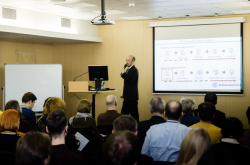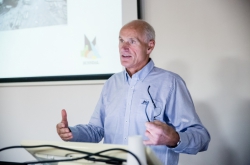Gunnar Olav Furu comes from the town of Sunndal located in the western part of Norway. A small village in fjords, by the end of WWII it turned into an industrial center with the biggest aluminum factory in the country. By 1970, 8,000 people lived in Sunndal, and it was then when the population started to decrease because of the pollution caused by the industry. Around this time, Gunnar was assigned to the position of the planning director at the municipality and was given a task to prevent further emigration. He decided to turn Sunndal into a nice place to live in and started with roads.
“Back then, the roads were very wide: 25 meters. Just like in Murmansk. We planted trees and established some places where people could park their cars. So the roads became eight meters wide. People didn’t like it at first; they didn’t want anything changed. Fortunately, the mayor and the city administration didn’t give up, and after a while, people got used to these innovations,” shares Mr. Furu.

Here is Gunnar Furu’s take on the components of a perfect city:
Make it comfortable. It is important to give people places where they can meet with friends for a cup of coffee or just walk. What is important, these places should be comfortable to use and easy to locate. For example, there is a very beautiful park near Primorskaya metro station, but if you don’t know where it is, you’ll probably have difficulty finding it.
Make long-term plans. Innovations usually take time to gain acceptance, so set your goals from the beginning and follow your plan.
Limit the city-center. It’s good when all the cafes and shops are situated in one place so that people don’t have to waste time getting from one spot to another. This idea is harder to implement in big cities like St. Petersburg but there could be several such centers.

Increase the number of people who use bicycles in their everyday lives. For example, in Copenhagen, the capital of Denmark, 60% of people use bikes every day. The city authorities supported this initiative and now Copenhagen sets an example for the whole Europe. The same can be done in St. Petersburg. It’s all up to the city authorities and the citizens themselves.
Support tourism. Tourism, and especially trekking, is very popular in Norway in general, and in Sunndal as well.
Encourage big companies to collaborate with local authorities. Why is it important? Small industrial cities owe their origin to their industries, but the people who live and work there also want their cities to be comfortable to live in. Big companies have enough resources to help people in their pursuit. In Sunndal, there is a company Norsk Hydro, which often launches joint recycling projects with the town’s administration.

The meeting with ITMO students was held in a dialogue format, as the expert wanted to hear other participants’ opinions.
According to Marina Lebedeva, Deputy Dean of ITMO’s Faculty of Technological Management and Innovations, Sunndal is a perfect example of a Scandinavian city which has changed dramatically for the better.

“Over the last 30 years, Norway, Sweden, and Finland have become world leaders in creating a comfortable environment for their citizens, a place where people want to live. 30 years is not a very long period of time. We have to catch up with them. But how? Moscow is doing a good job. In St. Petersburg, it’s a bit harder to get funding, but it doesn’t mean it’s impossible, as we can attract talented creative people and volunteers to solve these tasks. We can also influence the city administration. It really works. Look at all these bike rides in St. Petersburg; though they aren’t perfect yet, it’s only the beginning. It’s an indicator that the citizens and the authorities think about changing the city for the better.”



